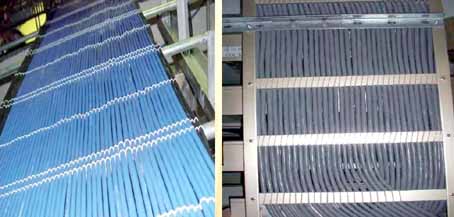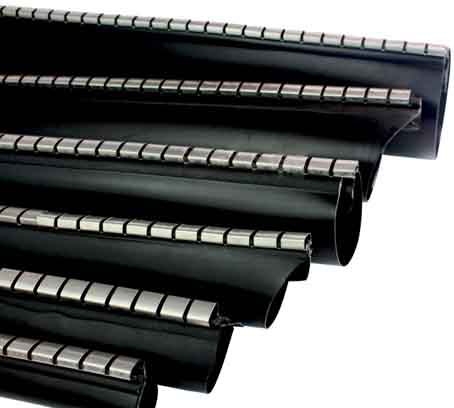Installation safety and protection of wires and cables
1. When the cables are installed crossing each other, the high-voltage cables should be under the low-voltage cables. If one of the cables is protected by a pipe or separated by a partition within 1m before and after the intersection, the minimum allowable distance is 0.25m.
2. When the cable is installed close to or crossed with heating pipes, if heat insulation measures are provided, the minimum installation distances for parallel and cross are 0.5m and 0.25m respectively.
3. When the cable is installed across the railway or road, it should be protected by a pipe. The protective pipe should extend 2m beyond the track or road.
4. The distance between the cable and the foundation of the building should be able to ensure that the cable is buried outside of the building's scattered water; When the cable is introduced into the building, it should be protected by a pipe, and the protective pipe should also be higher than the building's bulk water.
5. The distance between the cable directly buried in the ground and the ground of the general grounding device should be 0.25~0.5m; The buried depth of cables directly buried in the ground should generally not be less than 0.7m, and should be buried under the frozen soil layer.


2. When the cable is installed close to or crossed with heating pipes, if heat insulation measures are provided, the minimum installation distances for parallel and cross are 0.5m and 0.25m respectively.
3. When the cable is installed across the railway or road, it should be protected by a pipe. The protective pipe should extend 2m beyond the track or road.
4. The distance between the cable and the foundation of the building should be able to ensure that the cable is buried outside of the building's scattered water; When the cable is introduced into the building, it should be protected by a pipe, and the protective pipe should also be higher than the building's bulk water.
5. The distance between the cable directly buried in the ground and the ground of the general grounding device should be 0.25~0.5m; The buried depth of cables directly buried in the ground should generally not be less than 0.7m, and should be buried under the frozen soil layer.

Cable protection measures
With the rapid development of power cable buried laying projects, higher requirements are put forward for cable protection. The cable protection sleeve is made of polyethylene PE and high-quality steel pipe after sandblasting and shot blasting, dipping or coating, and heating and curing. It is the most commonly used electrical insulating tube for protecting wires and cables. It is widely used because of its good insulation properties, high chemical stability, no rust, no aging, and adaptability to harsh environments.
Using cable protection sleeves to protect cables can achieve the following advantages:
1. Good corrosion resistance, long service life, and can be used in wet saline-alkali areas.
2. Flame retardant and good heat resistance. Can be used for a long time at a high temperature of 130 degrees without deformation, and will not burn in fire.
3. High strength and high rigidity. It is used for direct burial under the carriageway without adding a concrete protective layer, which can speed up the progress of the cable project construction.
4. Whether the cable protective sleeve is a pipe or a pipe fitting, it has a certain degree of flexibility and can resist damage caused by strong external pressure and foundation settlement.
5. It has good anti-interference performance of external signals.
6. The inner wall is smooth and does not scratch the cable. The design adopts the socket connection mode, which is convenient for installation and connection. The rubber sealing ring seal at the joint not only adapts to thermal expansion and contraction, but also prevents mud and sand from entering.
With the rapid development of power cable buried laying projects, higher requirements are put forward for cable protection. The cable protection sleeve is made of polyethylene PE and high-quality steel pipe after sandblasting and shot blasting, dipping or coating, and heating and curing. It is the most commonly used electrical insulating tube for protecting wires and cables. It is widely used because of its good insulation properties, high chemical stability, no rust, no aging, and adaptability to harsh environments.
Using cable protection sleeves to protect cables can achieve the following advantages:
1. Good corrosion resistance, long service life, and can be used in wet saline-alkali areas.
2. Flame retardant and good heat resistance. Can be used for a long time at a high temperature of 130 degrees without deformation, and will not burn in fire.
3. High strength and high rigidity. It is used for direct burial under the carriageway without adding a concrete protective layer, which can speed up the progress of the cable project construction.
4. Whether the cable protective sleeve is a pipe or a pipe fitting, it has a certain degree of flexibility and can resist damage caused by strong external pressure and foundation settlement.
5. It has good anti-interference performance of external signals.
6. The inner wall is smooth and does not scratch the cable. The design adopts the socket connection mode, which is convenient for installation and connection. The rubber sealing ring seal at the joint not only adapts to thermal expansion and contraction, but also prevents mud and sand from entering.






